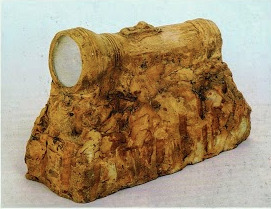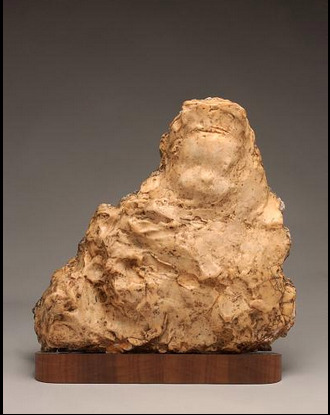Happy Birthday to Jasper Johns! In honor of this special occasion, CIMA 2014-15 Fellow Francesco Guzzetti takes a look at Rosso and Johns:
All of us agree about the key role played by the Italian sculptor Medardo Rosso in the development of modern art between the 19th and 20th centuries—a role that has been brought into greater focus this year with the Rosso exhibition at CIMA. But, does the question of a long-lasting legacy of Rosso’s work throughout the whole of the 20th century make sense? That was the recurrent question during my six-month fellowship at CIMA this year. The conclusion is that it definitely makes sense. The answers are few, but meaningful. And a remarkable witness to Rosso’s legacy involves one of the most widely acclaimed masters of postwar art: Jasper Johns.
The common ground they share is not banal; it concerns a new conception of sculpture, a redefinition of the tenets of the three-dimensional object, and the choice and treatment of uncommon, untraditional materials—such as wax and plaster in the case of Rosso, and plaster and Sculp-metal for Johns.
Take, for example, Johns’ series entitled Flashlight, especially Flashlight III, made in 1958. The artist cast in plaster a real flashlight, covering it with rough plaster material. In the other pieces of the series he used Sculp-metal, a pliable claylike substance that, when dry, emulates cast metal.

Now, look at Child in the Soup Kitchen, a posthumous wax version of a 1893 sculpture by Rosso now in the Hirshhorn Museum and Sculpture Garden in Washington DC. In this case, the outlines of the face of a child are really “drowned” into a raw amount of plaster covered with wax.

Unfortunately, I cannot claim any authorship or originality for this very smart comparison. In fact, two large plates of these pieces appeared in a crucial book on Jasper Johns published in 1967 by the American critic Max Kozloff. In the book Kozloff pointed out all the common grounds between the two artists, finding in the two works the same “synesthetic” approach towards sculpture, as he termed it. In fact, the rough surfaces involve a truly pictorial concern for the play of light and shadow, materialized in a tactile conception of material.
This very early essay on Johns’s work becomes a crucial occurrence of Rosso’s name in the debates around contemporary art in the 1960s in the United States—just four years after the retrospective on Rosso at the Museum of Modern Art and the monograph published by Margaret Solari Barr, the true starting points of the reception of Rosso in the US.
The mix of visual and tactile features, in other words of painting and sculpture, is really one of the most remarkable achievement in Rosso’s oeuvre, and actually the key way through which Johns created his pieces, thus questioning the referential meaning of artwork and establishing a new “objecthood” in art.
I would like to thank CIMA member Neil Printz, editor of the Andy Warhol Catalogue Raisonné, for discussing this subject with me and helping me to develop it.
